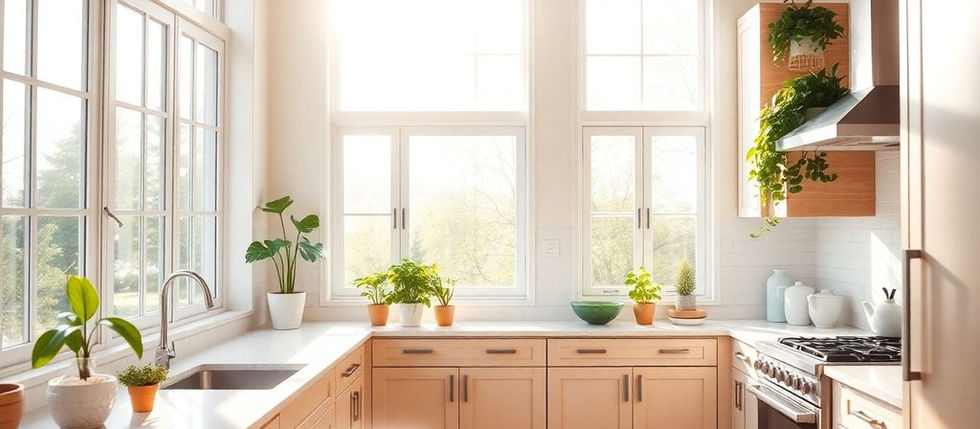The kitchen is often called the heart of the home, and its design is crucial for both cooking and family gatherings. One of the most important aspects of a kitchen's design is lighting. The right lighting can change a kitchen from just a place to cook into a lively and inviting space. This article explores innovative lighting ideas for kitchen remodels, showing how good lighting can improve the look and feel of your kitchen, making it not just functional but also a beautiful part of your home.
Key Takeaways
Layered lighting combines ambient, task, and accent lights for a versatile kitchen.
Pendant lights add style and can be positioned to highlight key areas like islands.
Recessed lighting offers a clean look and can create depth in modern kitchens.
Smart lighting systems enhance convenience and energy efficiency with features like voice control.
Natural light through large windows or skylights can improve mood and reduce the need for artificial lighting.
Layered Lighting for a Functional Kitchen
Creating a functional kitchen requires a thoughtful approach to lighting. Layered lighting combines different types of illumination to enhance both usability and style. This method includes three main types of lighting: ambient, task, and accent.
Understanding Ambient, Task, and Accent Lighting
Ambient Lighting: This is the main source of light in your kitchen, providing a warm and welcoming atmosphere. It can come from ceiling fixtures or natural light.
Task Lighting: Focused lighting that helps you perform specific tasks, such as cooking or chopping. Examples include under-cabinet lights and pendant lights over the island.
Accent Lighting: This adds character and highlights certain features, like artwork or architectural details. It can be achieved with spotlights or decorative fixtures.
Integrating Smart Home Automation
Incorporating smart home technology can elevate your kitchen lighting experience. With smart systems, you can:
Control Lighting Remotely: Adjust brightness and color from your smartphone.
Set Schedules: Program lights to turn on or off at specific times.
Use Voice Commands: Easily change settings with simple voice instructions.
Balancing Light Layers for Versatility
To achieve a well-lit kitchen, balance your lighting layers:
Combine Different Types: Use ambient, task, and accent lighting together for a versatile space.
Install Dimmers: These allow you to adjust brightness based on the time of day or activity.
Choose the Right Fixtures: Ensure that your lighting fixtures match your kitchen's style and provide adequate illumination.
In summary, layered lighting is essential for a functional kitchen. It not only meets practical needs but also enhances the overall ambiance, making your kitchen a true reflection of your style and personality. Remember, the right lighting can transform your culinary space into a warm and inviting area for cooking and gathering.
Pendant Lighting: Style Meets Functionality
Pendant lighting is not just about providing light; it’s also about making a statement in your kitchen. These fixtures can truly enhance your kitchen's style while serving practical purposes. Here are some key points to consider:
Choosing the Right Pendant for Your Kitchen
Style Match: Select pendants that fit your kitchen's overall design. Whether you prefer modern, rustic, or vintage styles, there’s a pendant for every taste.
Material Matters: Look for materials like glass, metal, or wood to add texture and interest. Natural elements can create a warm atmosphere.
Size and Scale: Ensure the size of the pendant is appropriate for your space. Oversized pendants can become focal points, while smaller ones can complement other decor.
Positioning Pendants for Maximum Impact
Above the Island: Hang pendants over the kitchen island for both task lighting and style. This is often the best spot for them.
Varying Heights: Experiment with hanging pendants at different heights to create a dynamic look. This can also help illuminate a larger area effectively.
Spacing: If using multiple pendants, space them evenly to maintain balance and visual appeal.
Experimenting with Sizes and Styles
Mix and Match: Don’t be afraid to combine different styles and sizes. This can add character and uniqueness to your kitchen.
Color Choices: Choose colors that either contrast or complement your kitchen’s palette. Bright colors can add a fun touch, while neutral tones can keep it sophisticated.
Highlighting Features: Use pendant lighting to draw attention to specific areas, like artwork or decorative shelves.
For those looking to elevate their kitchen, shop allmodern for modern and contemporary pendant lighting to match your style and budget. Enjoy free shipping on most stuff, even big stuff!
Recessed Lighting for a Sleek Look
Recessed lighting can give your kitchen a clean and modern feel. When placed correctly, it adds depth and dimension to the space. This type of lighting is perfect for those who prefer a minimalist design. Here are some key points to consider:
Benefits of Recessed Lighting in Modern Kitchens
Sleek Appearance: Recessed lights are hidden in the ceiling, making them less obtrusive.
Versatile Lighting: They can be used for general lighting or to highlight specific areas.
Adjustable Options: Using adjustable recessed lights allows you to direct light where it’s needed most.
Strategic Placement for Depth and Dimension
To make the most of recessed lighting, think about where to place them:
Over Work Areas: Install lights above countertops and islands for task lighting.
Highlight Features: Use them to accentuate artwork or architectural details.
Layering: Combine with other lighting types for a balanced look.
Combining Recessed Lighting with Other Fixtures
While recessed lights are great, they should not be the only source of light. As noted in a common concern, "recessed lights alone can feel overly bright and clinical" if not paired with other lighting options. Consider these combinations:
Pendant Lights: Hang them over islands for style and function.
Under-Cabinet Lighting: This helps eliminate shadows and enhances visibility.
Dimmable Options: Installing dimmers allows you to adjust the brightness based on your needs.
Incorporating Smart Lighting Systems
Smart lighting systems can greatly enhance your kitchen experience. These systems allow for easy control and customization of your kitchen lights, making them more functional and convenient. Here are some key features:
Features of Smart Lighting for Kitchens
Motion Sensors: Automatically turn lights on or off when you enter or leave the room.
Programmable Scenes: Set different lighting moods for cooking, dining, or relaxing.
Voice Activation: Use voice commands to control your lights without lifting a finger.
Enhancing Convenience with Voice Activation
Imagine walking into your kitchen and saying, "Turn on the kitchen lights," and they respond instantly. This feature not only adds convenience but also makes your kitchen more accessible for everyone.
Energy Efficiency and Customization
Smart lighting can help save energy. By using LED bulbs and smart controls, you can reduce electricity usage. Here’s a quick comparison of energy consumption:
Incorporating smart lighting into your kitchen remodel can lead to a more enjoyable cooking experience. With features like motion sensors and voice activation, you can create a space that is both stylish and practical. Don't forget to explore the various options available to find the best fit for your needs!
Artistic and Statement Lighting Fixtures
Using Lighting Fixtures as Art Pieces
Lighting can be more than just a source of illumination; it can also be a form of art. Unique fixtures like sculptural pendants or abstract chandeliers can add a personal touch to your kitchen. These pieces can serve as conversation starters and enhance the overall design of your space.
Selecting Sculptural and Abstract Designs
When choosing artistic lighting, consider:
Sculptural shapes that draw the eye.
Abstract designs that complement your kitchen's style.
Colorful finishes that add vibrancy to the room.
Creating Focal Points with Bold Fixtures
To make a statement, position bold fixtures in key areas:
Hang a large chandelier above the dining table.
Use oversized pendants over the kitchen island.
Incorporate unique wall sconces to highlight artwork.
Incorporating artistic lighting not only brightens your kitchen but also adds a layer of creativity and style that reflects your personality. Choose fixtures that resonate with you and create a space that feels uniquely yours.
Maximizing Natural Light in Your Kitchen
Designing with Large Windows and Skylights
To truly maximize natural light in your kitchen, consider incorporating large windows and skylights. These features can flood your space with sunlight, creating a bright and airy atmosphere. Strategic window placement is essential to ensure that light reaches all corners of the room. Here are some tips:
Use floor-to-ceiling windows for a dramatic effect.
Install skylights to bring in light from above.
Choose window styles that open easily for ventilation.
Balancing Natural and Artificial Light
While natural light is fantastic, it’s important to balance it with artificial lighting for those cloudy days or evenings. Here’s how:
Use dimmable lights to adjust brightness as needed.
Combine ambient lighting with task lighting for functionality.
Consider light-reflective materials in your decor to enhance brightness.
Enhancing Mood and Well-being with Sunlight
Natural light not only brightens your kitchen but also boosts your mood. Embracing sunlight can lead to a more enjoyable cooking experience. Here are some benefits:
Increases energy levels and productivity.
Creates a welcoming environment for family and friends.
Reduces the need for artificial lighting, saving energy.
In conclusion, maximizing natural light in your kitchen involves thoughtful design choices. From large windows to strategic placements, every detail counts in creating a bright and cheerful culinary space.
Eco-Friendly and Sustainable Lighting Solutions
Choosing Energy-Efficient Bulbs and Fixtures
When remodeling your kitchen, selecting energy-efficient lighting is crucial. Here are some options:
LED bulbs: These use less energy and last longer than traditional bulbs.
CFL bulbs: Compact fluorescent lights are another energy-saving choice.
Solar-powered lights: Great for areas with plenty of sunlight, these lights harness natural energy.
Incorporating Renewable Energy Sources
Using renewable energy can significantly reduce your kitchen's carbon footprint. Consider:
Solar panels: Install them on your roof to power your kitchen lights.
Wind turbines: If you have space, small turbines can generate energy.
Energy storage systems: Store energy for use during cloudy days or at night.
Sustainable Design Practices for Kitchens
To create a truly eco-friendly kitchen, think about:
Recycled materials: Use fixtures made from recycled glass or metal.
Local sourcing: Choose products made nearby to reduce transportation emissions.
Smart lighting systems: These can adjust based on natural light, saving energy.
By focusing on these sustainable practices, you can create a kitchen that is both stylish and environmentally friendly. Remember, every small change contributes to a larger impact!
Final Thoughts on Kitchen Lighting
In conclusion, using creative lighting ideas can completely change your kitchen, blending usefulness with style. By mixing different types of lights and adding smart technology, you can create a space that is not only practical but also inviting. Think about how you want your kitchen to feel and look, and choose lighting that matches your vision. With the right approach, your kitchen can become a bright and beautiful part of your home, making cooking and gathering with family even more enjoyable.
Frequently Asked Questions
What types of lighting should I use in my kitchen?
You should consider using a mix of ambient, task, and accent lighting. Ambient lighting provides overall illumination, task lighting focuses on work areas, and accent lighting highlights specific features.
How do I choose the right pendant lights for my kitchen?
When picking pendant lights, think about the style of your kitchen and choose fixtures that match. Also, consider the size and height to ensure they fit well in your space.
What are the benefits of recessed lighting?
Recessed lighting is great for a clean look and can make your kitchen feel more spacious. It provides even light without taking up visual space.
Can smart lighting really make a difference in my kitchen?
Yes! Smart lighting allows you to control brightness and colors easily. You can set schedules or use voice commands, making your kitchen more convenient.
How can I maximize natural light in my kitchen?
To get more natural light, use large windows or skylights. You can also use light colors for your walls and decor to reflect sunlight better.
What are eco-friendly lighting options for kitchens?
Look for energy-efficient bulbs, like LEDs, and consider fixtures made from sustainable materials. Using solar-powered lights is also a great eco-friendly choice.















Comentários